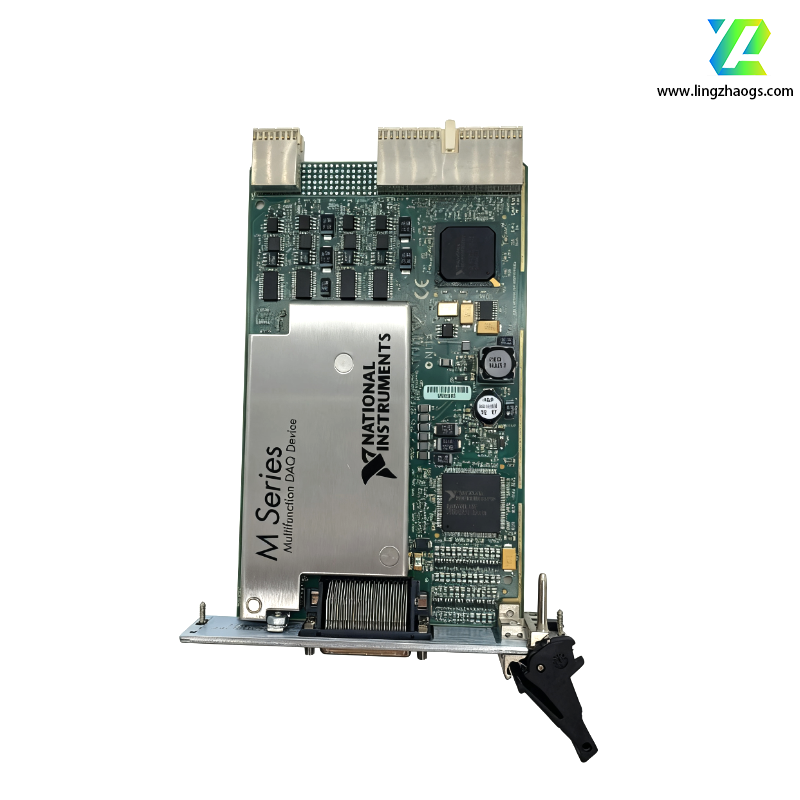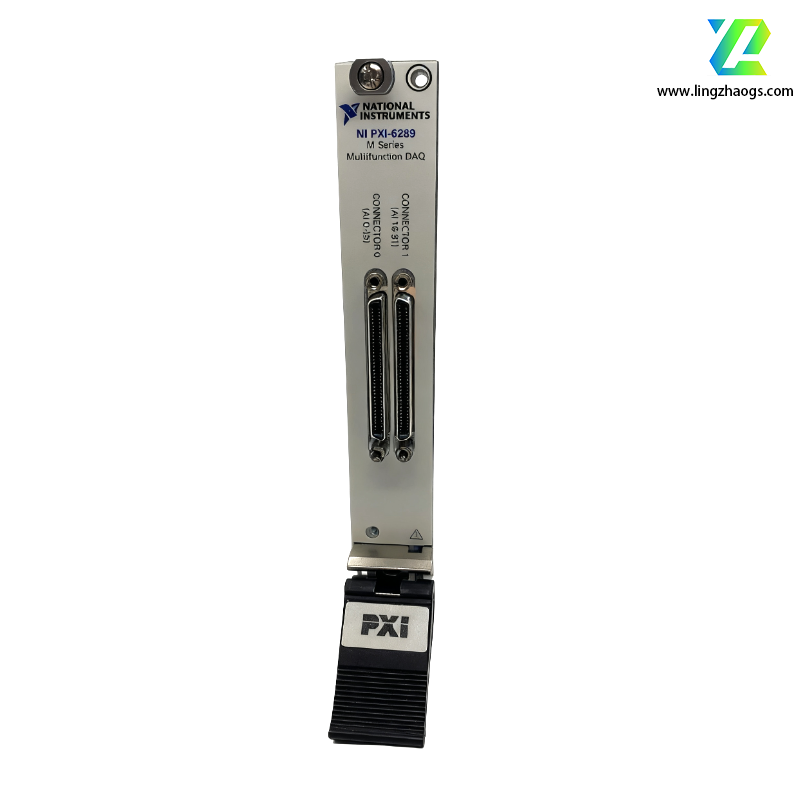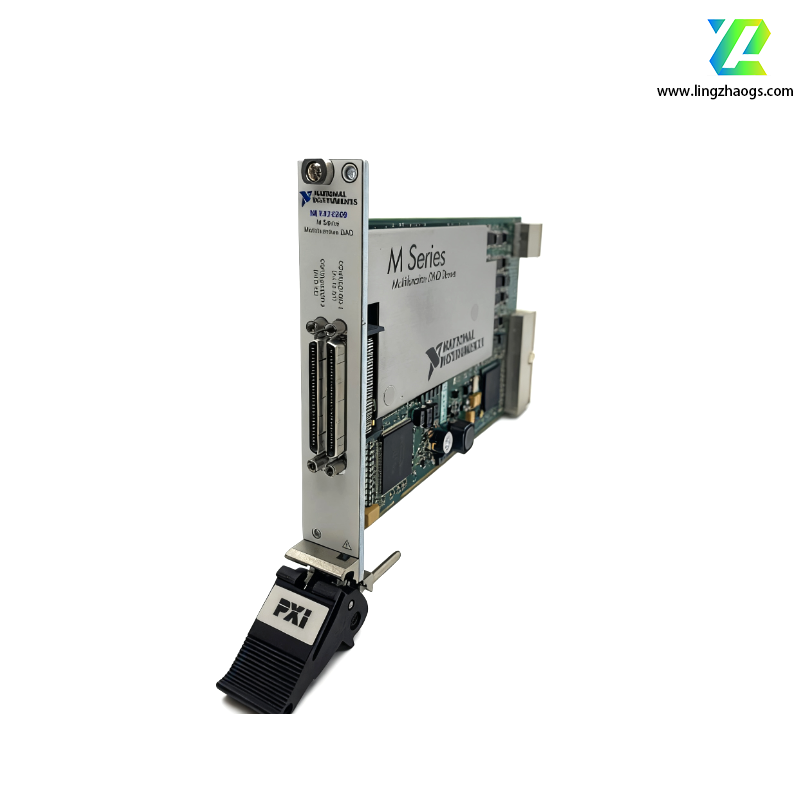Detailed Specifications of NI PXI-6289 Isolated Multifunction DAQ Module
The NI PXI-6289 is a high-reliability isolated multifunction data acquisition (DAQ) module from National Instruments (NI)’s M-Series, engineered for the PXI bus architecture. Its key differentiator is galvanic isolation for analog channels, which eliminates ground loops and suppresses high-voltage noise—critical for harsh industrial environments. Integrating precision analog I/O, flexible digital functions, and high-accuracy timing, it is ideal for measurement and control tasks in noisy or high-voltage scenarios like power electronics testing, industrial process monitoring, and aerospace system validation.
1. Basic Information
- Module Series: M-Series isolated multifunction DAQ module, optimized for PXI systems
- Part Number: 779081-01 (standard model)
- Physical Dimensions: 3U PXI standard size, 3.8 inches × 6.1 inches (approximately 9.65cm × 15.49cm)
- Weight: Approximately 6.5 ounces (0.18kg) (heavier than non-isolated models due to isolation components)
- Interface Type: 68-pin VHDCI (Very High-Density Cable Interconnect) interface, with isolated signal paths for analog channels
- Operating Temperature Range:
- Commercial grade: 0°C ~ 55°C
- Extended grade (optional): -40°C ~ 85°C (suitable for extreme industrial conditions)
- Environmental Protection Ratings:
- Shock Resistance: 100g peak (duration of 11ms)
- Vibration Resistance: 5g RMS (frequency range 10Hz ~ 500Hz)
- Dust Protection: IP30 (prevents intrusion of solid foreign objects)
- Analog Channels: 2,500Vrms (galvanic isolation between analog inputs/outputs and system ground)
- Digital I/O: 500Vrms (isolation between digital lines and system ground)
2. Core Technical Specifications
2.1 Analog Input
- 16 single-ended inputs / 8 differential inputs (all channels isolated)
- Supports Referenced Single-Ended (RSE), Non-Referenced Single-Ended (NRSE), and Differential (DIFF) modes
- Resolution: 16-bit ADC (Analog-to-Digital Converter), no missing codes (differential nonlinearity error ±0.5 LSB)
- Maximum single-channel rate: 1.0 MS/s (mega samples per second)
- Multi-channel aggregate rate: 800 kS/s (stable synchronous acquisition in multiplexing mode)
- Input Ranges: 7 switchable ranges to match signal amplitudes: ±0.1V, ±0.2V, ±0.5V, ±1V, ±2V, ±5V, ±10V
- When powered on: ±30V (higher tolerance than non-isolated models)
- Maximum input current per channel: ±20mA (prevents damage from signal surges)
- Key Performance Indicators:
- Input Impedance: >10 GΩ (with 100pF parallel capacitor) when powered on; 1kΩ when powered off
- Common Mode Rejection Ratio (CMRR): 110dB (DC ~ 60Hz) (enhanced by isolation, ideal for noisy environments)
- Small Signal Bandwidth (-3dB): 1.5MHz
- Settling Time: 2μs (step error ±60ppm) for ±1V ~ ±10V ranges; 10μs (step error ±15ppm) for ±0.1V/±0.2V ranges
- Buffer Memory: 8,191-sample input FIFO (First-In-First-Out) buffer, reducing CPU load during high-volume data acquisition
2.2 Analog Output
- Channel Count: 4 independent isolated analog output channels
- Resolution: 16-bit DAC (Digital-to-Analog Converter), integral nonlinearity error ±1 LSB, differential nonlinearity error ±0.5 LSB
- Update Rate: Maximum single-channel rate of 2.0 MS/s (supports high-speed waveform generation)
- Output Range: ±10V (standard)
- Continuous output: ±5mA per channel
- Peak output: ±20mA per channel (compatible with industrial actuators and drivers)
- Output Impedance: Typical value 0.2Ω (slightly higher than non-isolated models due to isolation circuitry)
- Short-circuit protection (current limited to ±20mA)
- Overvoltage protection (±15V)
2.3 Digital I/O
- Number of I/O Lines: 24 programmable digital I/O lines (500Vrms isolated)
- Logic Level: Compatible with 5V TTL/CMOS standards
- Configuration Method: Each line independently configurable as input or output via software; supports push-pull/open-drain output
- Drive Current: 24mA sink current/source current per line (meets industrial component driving needs)
- Timing Accuracy: 20MHz internal clock, supporting digital signal sampling and generation up to 10MHz
- Function Support: Digital triggering, correlated I/O (synchronized with analog I/O), pattern generation; suitable for controlling relays, solenoids, or monitoring sensor status in noisy environments
2.4 Counter/Timer
- Configuration Specification: 2 independent 32-bit counters/timers, 80MHz reference clock (ensures high-precision timing)
- Clock Sources: Supports internal (0.1MHz, 20MHz, 80MHz) or external (0~20MHz) clock input
- Event counting (e.g., pulse count statistics)
- Frequency measurement (up to 10MHz)
- Period measurement (minimum 100ns)
- Time interval measurement (resolution 50ns)
- Pulse Width Modulation (PWM)
- Pulse generation (custom duty cycle and frequency)
- Synchronization Integration: Synchronizable with analog I/O and digital I/O via PXI backplane; isolation does not affect synchronization precision (nanosecond-level alignment)
2.5 Synchronization and Triggering
- Synchronization Capability:
- Achieves nanosecond-level clock synchronization via PXI backplane trigger lines (PXI_Trig) and PXI Star Trigger (PXI_Star)
- Supports phase-coherent acquisition across multiple PXI-6289 modules or other M-Series modules (even with isolation enabled)
- Analog Edge Trigger: Configurable rising/falling edge, threshold range ±10V (triggers based on analog signal levels, isolated from system ground)
- Digital Edge Trigger: TTL-level compatible, rising/falling edge support (isolated digital lines prevent noise interference)
- Software Trigger: Triggered via API commands (suitable for automated test sequences)
- Signal Conditioning Compatibility: Seamlessly integrates with NI SCC (Signal Conditioning Cartridge) and SCXI modules (e.g., SCXI-1125 for amplification, SCXI-1144 for additional isolation); isolation enhances compatibility with high-noise sensors (e.g., current transducers in power systems)
3. Software and Driver Support
- Drivers: NI-DAQmx 9.0 and above (recommended); NI-DAQmx Base is also supported. Drivers include dedicated APIs for configuring isolation settings (e.g., isolating specific analog channels) to optimize noise suppression.
- Programming Compatibility:
- NI Native Software Ecosystem: Fully compatible with LabVIEW (8.2.x and above), LabWindows/CVI (8.1.x and above), Measurement Studio (8.0.x and above), and LabVIEW SignalExpress (2.5.x and above). LabVIEW provides graphical tools for visualizing isolation performance (e.g., noise reduction metrics).
- Third-Party Programming Languages: Supports C/C++, C#, MATLAB (via NI-DAQmx Toolbox), and Python (via pyDAQmx binding library); enables integration with power system analysis software (e.g., PSCAD/EMTDC for power electronics testing)
- Calibration Function: Built-in NI-MCal (Modular Calibration) technology, which automatically compensates for isolation-induced nonlinearity, offset, and gain errors. Recommended calibration cycle: 2 years (ensures analog input accuracy ±0.015% full scale, even with isolation enabled)
- Isolation integrity self-test (verifies isolation barrier continuity to prevent safety risks)
- Real-time noise monitoring (via driver APIs)
- Error logging (records isolation-related faults, e.g., overvoltage events)
4. Typical Application Scenarios
The NI PXI-6289’s isolation feature makes it ideal for noise-sensitive and high-voltage applications:
- Power Electronics Testing: Measurement of voltage/current in inverters, converters, and battery management systems (BMS); isolation eliminates ground loops between power circuits and measurement systems
- Industrial Process Control: Monitoring of temperature, pressure, and flow in chemical plants or oil refineries; isolation protects the DAQ system from high-voltage transients (e.g., from motor drives)
- Aerospace and Defense: Testing of avionics power supplies or missile guidance systems; extended temperature range and isolation ensure reliability in harsh environments
- Biomedical Equipment Testing: Calibration of medical devices (e.g., MRI power supplies); isolation prevents electrical interference with sensitive biomedical sensors
- Renewable Energy Systems: Monitoring of solar inverters or wind turbine converters; isolation suppresses noise from grid-connected power electronics (e.g., switching noise from IGBTs)
5. Selection and Compatibility Notes
- Applicable Scenarios: Scenarios requiring 1.0 MS/s sampling rate, 16-bit precision, and galvanic isolation (e.g., power systems, high-noise industrial environments); especially suitable for applications where ground loops are common (e.g., multi-sensor setups across large factories)
- Comparison with Non-Isolated Models:
- vs. NI PXI-6259: PXI-6289 offers isolation (2,500Vrms) but slightly lower sampling rate (1.0 MS/s vs. 1.25 MS/s); choose PXI-6289 for noise-sensitive tasks, PXI-6259 for higher-speed non-isolated applications
- vs. NI PXI-6281: PXI-6289 has 4 analog outputs (vs. 2 for PXI-6281) and higher isolation rating (2,500Vrms vs. 1,000Vrms); suitable for multi-output control in high-voltage systems
- Compatible with all NI 3U PXI chassis (e.g., PXI-1042, PXIe-1075) and third-party PXI-compatible chassis; isolation does not require special chassis modifications
- Supports DMA (Direct Memory Access) scatter-gather transfer (maximum 132 MB/s), ensuring high-speed data transfer even with isolation-enabled noise filtering
- Notes: Isolation increases power consumption (vs. non-isolated models); ensure the chassis power supply can meet the module’s 1.2A +5V requirement
- Compliance Certifications: Meets CE (EN 61326-1), FCC Part 15 Class A, UL 61010-1, IEC 61010-1, and IEC 61800-3 (for power electronics compatibility); isolation complies with IEC 61140 (protection against electric shock)





